Manually setting the wireless access point on a Mac OS X computer (MX410)
| Article ID: ART110401 | | | Date published: 05/11/2015 | | | Date last updated: 11/20/2015 |
Description
Manually enter the access point name / network name (SSID) and security setting (WEP, WPA,) during install.
Solution
Manually Setting the Wireless Access Point - Mac OS X
To manually set the wireless access point, you will need the access point name / network name (or SSID), the network key (also referred to as encryption key, WEP key or WPA / WPA2 passphrase, pre-shared key) and the encryption method.
Note:
If you are unable to retrieve the network key or other settings, refer to the manual of your access point or router, or contact its manufacturer.
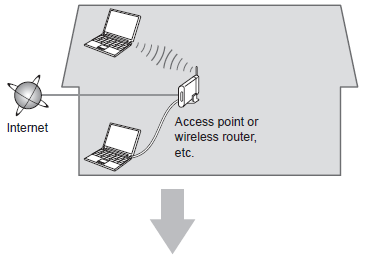
Add (connect) the machine to the network.
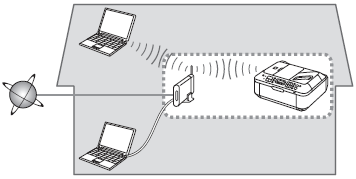
Notes on Wireless Connection
- The configuration, router functions, setup procedures and security settings of the network device vary depending on your system environment. For details, refer to your device's instruction manual or contact its manufacturer.
- Check if your device supports IEEE802.11n / g / b.
- In an office setup, consult your network administrator.
- If you connect to a network that is not protected with security measures, there is a risk of disclosing data such as your personal information to a third party.
- If an error message appears or if you have trouble with the network connection, refer to the printed manual: Network Setup Troubleshooting.
- When using a router, connect the machine and computer to the LAN side (same network segment).
Note: An "Ad-hoc connection," which establishes a direct connection to the computer over a wireless connection without using an access point, is not supported. Be sure to prepare an access point.
Install the Drivers
Do not connect the Wireless LAN setup cable (USB cable) yet.

Software installation requires temporary use of the Wireless LAN setup cable (USB cable).
- To use the machine by connecting it to a computer, software including the drivers needs to be copied (installed) to the computer's hard disk. The installation process takes about 20 minutes. (The installation time varies depending on the computer environment or the number of application software to be installed.)
IMPORTANT:
- Quit all running applications before installation.
- Log on as the administrator (or a member of the Administrators group).
- Do not switch users during the installation process.
- Internet connection may be required during the installation. Connection fees may apply. Consult the internet service provider.
- It may be necessary to restart your computer during the installation process. Follow the on-screen instructions and do not remove the Setup CD-ROM during restarting. The installation resumes once your computer has restarted.
- If the firewall function of your security software is turned on, a warning message may appear that Canon software is attempting to access the network. If such a warning message appears, set the security software to always allow access.
- Mac OS 9, Mac OS X Classic environments, or Mac OS X v.10.4.10 or earlier are not supported.
- Turn on the computer, then insert the Setup CD-ROM into the CD-ROM drive.

- Double-click the Setup icon
 of the CD-ROM folder to proceed to the following screen. Enter your administrator name and password, then click OK.
of the CD-ROM folder to proceed to the following screen. Enter your administrator name and password, then click OK.

- If the CD-ROM folder does not open automatically, double-click the CD-ROM icon
 on the desktop.
on the desktop.
- If you do not know your administrator name or password, click the help
 button, then follow the on-screen instructions.
button, then follow the on-screen instructions.
- If the CD-ROM folder does not open automatically, double-click the CD-ROM icon
- Click Easy Install.
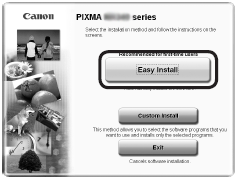
The drivers, application software, and on-screen manuals are installed all together.
Note: If you want to select particular items to install, click Custom Install.
- Click Install.
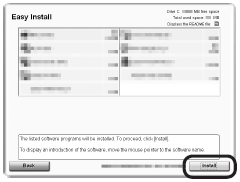
- Select Use the printer with wireless LAN connection, then click Next.
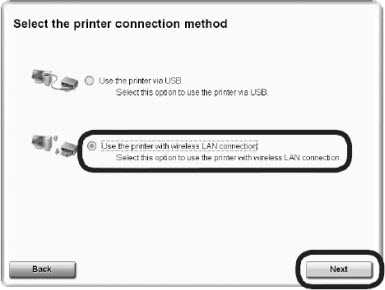
Follow any on-screen instructions to proceed with the software installation.
- When the Printer Detection screen appears, click Next.

Important:
If the Printer Connection screen appears instead of the above screen, the connection method is not selected correctly in step 5.
Follow on-screen instructions and proceed with the installation. Click Exit on the installation complete screen, then start again from step 2 and be sure to select Use the printer on network in step 5.
- Make sure that any of the lamps on the mode buttons (A) lights,, then click OK.
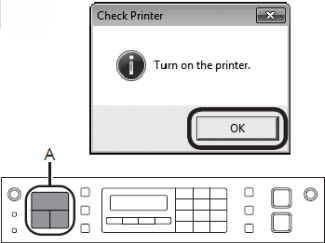
- When the Set Up New Printer screen appears, click Next.
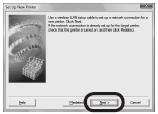
Note: If the Detected Printers List screen appears, click Set Up New Printer.
- Follow the on-screen instructions and click 'Next'.
When prompted, connect the machine to the computer with the network setup cable (USB cable).

Important:
There shouldn't be any resistance when connecting the USB cable to the printer. If the cable does not easily slide into the printer's port, look at the end of the connector. The shape of the connector should match the port on the printer.
All USB cables will have a USB icon on one side. The side of the cable where the icon is situated is different than the other three sides.Icon on USB Cable
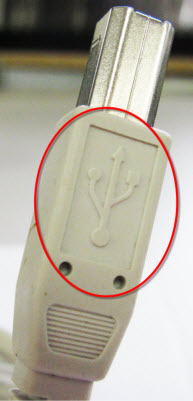
Shape of the USB Connector
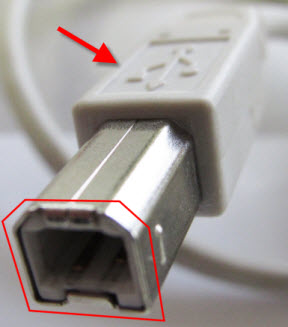
Note: If the Detected Access Points List screen appears, proceed to step 11.
- When the Confirm Connection Access Point screen appears, click No (A).
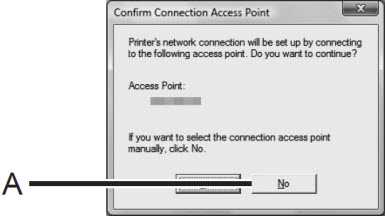
- At the Detected Access Points List dialog, click Manual Setup (B).

- At the Manual Setup dialog, enter the access point name / network name (SSID) in SSID box (C).
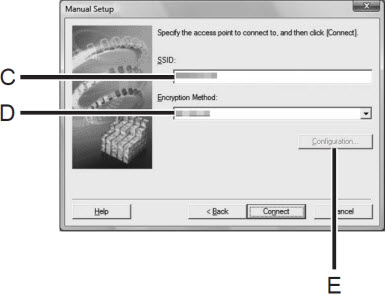
- Select the security protocol for the access point in Encryption Method (D) drop-down, then click Configuration (E).
- If you select Disable in Encryption Method, go to step 14.
- If you select WEP in Encryption Method, enter the network key in WEP Key (F).
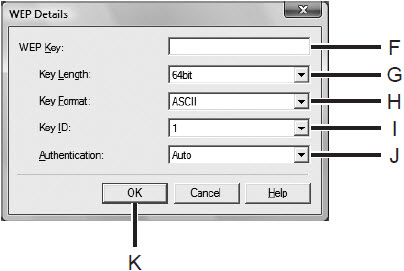
- Enter upper and lower case letters of the alphabet correctly when the network key is 5 or 13 characters. Letters are case sensitive.
Letters are not case sensitive if the network key is 10 or 26 characters (digits). - Select Key Length (G).
When WEP 40 bit is selected in AirPort Utility (AirPort Admin Utility), select 64 bit.
When WEP (Transitional Security Network) is selected in AirPort Utility, select 128 bit. - Select Key Format (H).
Select Characters when the network key is 5 or 13 characters.
Select Hexadecimal when it is 10 or 26 characters (digits). - Select Key ID (I).
When using AirPort, select 1 in the screen.
Selecting other key numbers will disable the connection between the machine and AirPort. - Select Authentication (J), then click OK (K).
- Go to step 14.
- Enter upper and lower case letters of the alphabet correctly when the network key is 5 or 13 characters. Letters are case sensitive.
- When WPA / WPA2 is selected in Encryption Method.
- Enter the network key in Passphrase (L).
Enter upper and lower case letters of the alphabet correctly when the network key is between 8 and 63 characters. Letters are case sensitive.
Letters are not case sensitive if the network key is 64 characters. - Select Dynamic Encryption Type (M), then click OK (N).
When WEP (Transitional Security Network) is selected in AirPort Utility, select AES(Secure Encryption).
When the access point is set to operate in IEEE802.11n, TKIP cannot be used.
Change the encryption type to something other than TKIP or change the standard to something other than IEEE802.11n, then configure wireless LAN settings again. - Go to step 14.
- Enter the network key in Passphrase (L).
- If you select Disable in Encryption Method, go to step 14.
- The Manual Setup screen returns. Click Connect.
- Follow the on-screen instructions to proceed with Printer and Scanner Registration.
Registration Printer and Scanner
- When the Register Printer and Scanner screen appears, click 'Register Printer'.
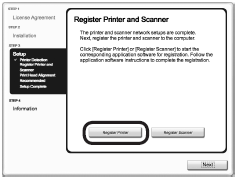
- Proceed to the section that relates to your operating system for further installation instructions.
Note:
The alphanumeric characters after Canon M410 series is the machine's Bonjour service name or MAC address.
Important:
If the machine has not been detected, make sure of the following.
* The machine is turned on.
* The firewall function of any security software is turned off.
* The computer is connected to the access point.- Mac OS X v.10.6.x / Mac OS X v.10.5.x
- Select Canon MX410 canonijnetwork and click Add.
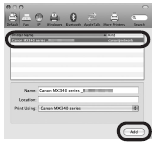
- Proceed to step 3.
- Select Canon MX410 canonijnetwork and click Add.
- Mac OS X v.10.4.11
- When the Printer List window appears, click Add.
Note: When the You have no printers available screen appears, click Add.

- Click More Printers in the Printer Browser window.
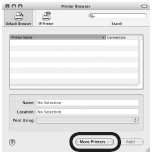
- Select Canon IJ Network in the pop-up menu, select Canon MX410 series in the list of printers, then click Add.
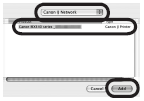
- Make sure that Canon MX410 series is added to the list of printers.

- Proceed to step 3.
- When the Printer List window appears, click Add.
- Mac OS X v.10.6.x / Mac OS X v.10.5.x
- When the Register Printer and Scanner screen appears, click Register Scanner.
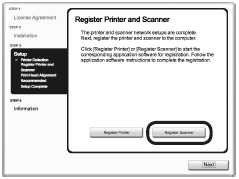
- Select Canon MX410 series on the Canon IJ Network Scanner Selector EX screen, then click OK.
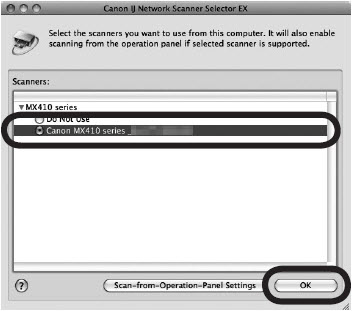
- Click Next on the Register Printer and Scanner screen.
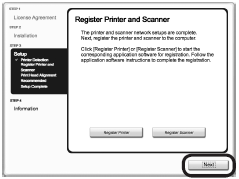
- Follow the on-screen instructions to complete the installation
Install the Software (Information)
- Click Next.
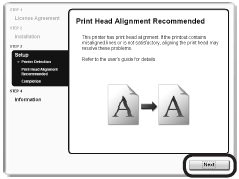
Follow any on-screen instructions to proceed with the software installation.
Important Information for the Installation
- Necessary Information for the User Registration
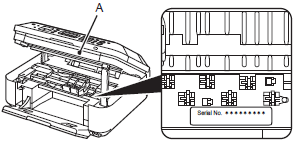
The product serial number is required when registering the product. The serial number is located inside the machine (as shown in the illustration).
Important:
If the power is on, the FINE Cartridge Holder will move when the Scanning Unit (Cover) (A) is opened.
- If the Extended Survey Program screen appears
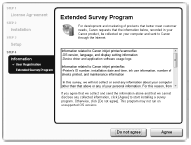
If you can agree to Extended Survey Program, click Agree.
If you click Do not agree, the Extended Survey Program will not be installed. (This has no effect on the machine's functionality.)
- Necessary Information for the User Registration
- Click Exit to complete the installation.
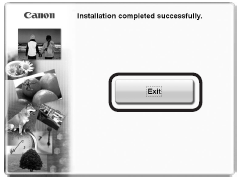
Important: It is necessary to restart the computer before scanning using the Operation Panel on the machine for the first time.
Note:- Remove the Setup CD-ROM and keep it in a safe place.
- The buttons displayed on Solution Menu may vary depending on the country or region of purchase.
- Solution Menu EX starts when clicking OK in the Canon Solution Menu EX dialog.
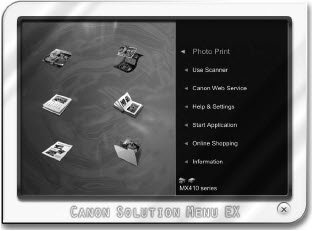
Using the Machine from Additional Computers
Now that the wireless connection of the machine is complete, it can be used from additional computers on the same network.
- Insert the Setup CD-ROM into the computer from which you want to use the machine.
- Follow the on-screen instructions to install the software.
Other settings are not required.
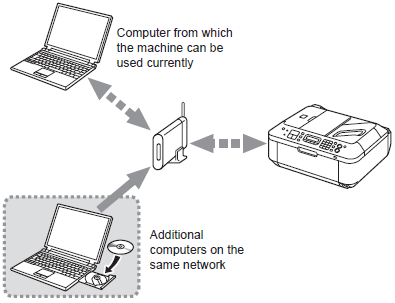
SIMS Doc Id
0

